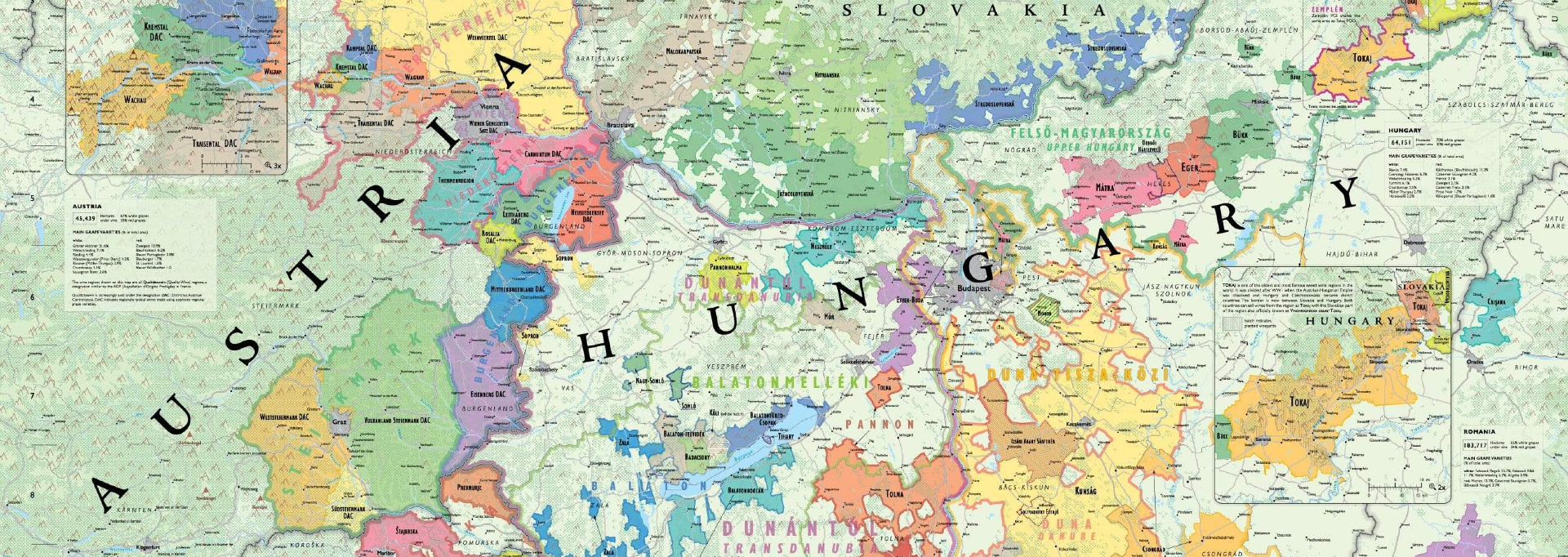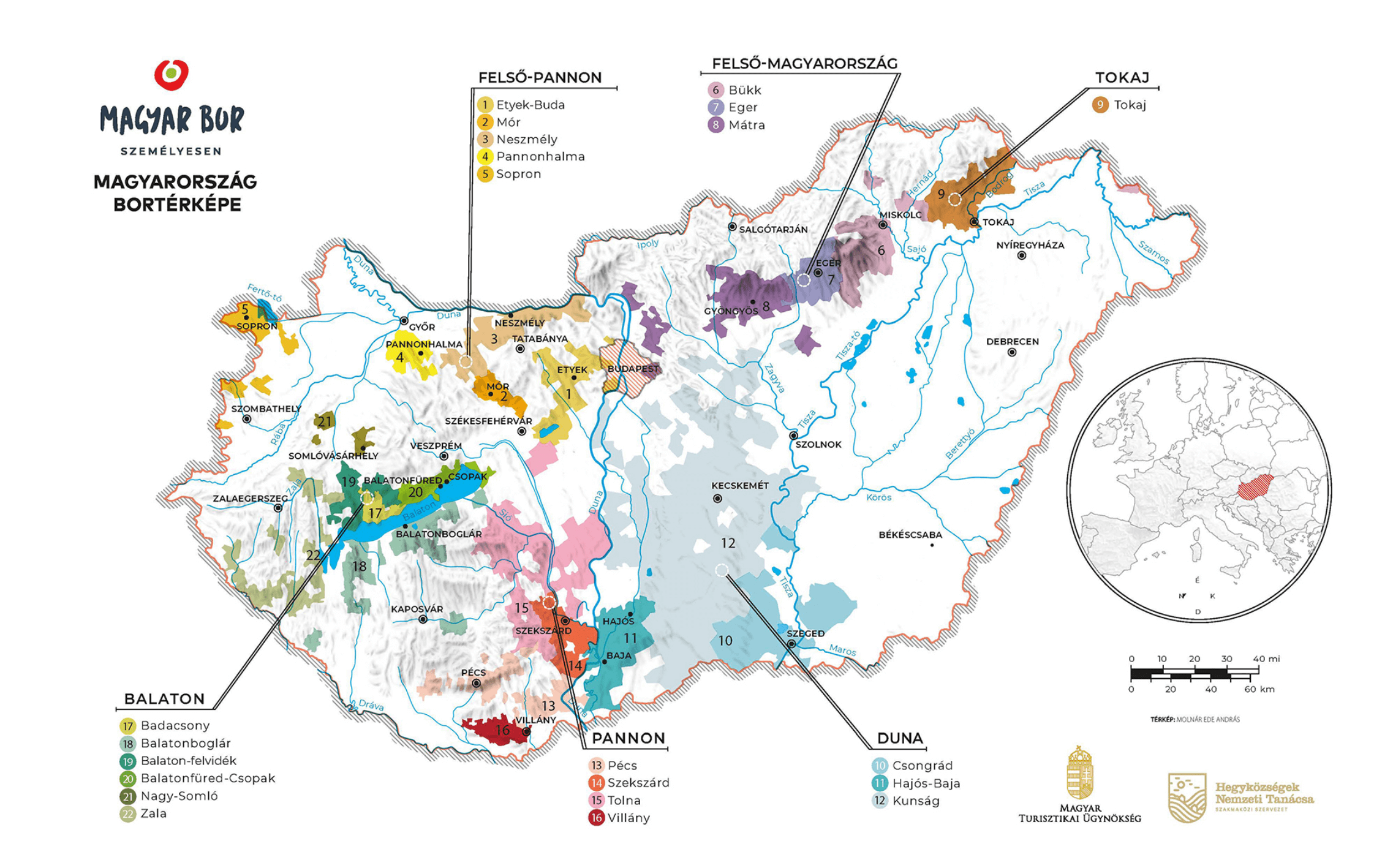

A Painfully Abbreviated Tour of Hungarian Wine Regions

Hungary has 22 distinct wine appellations across 6 major regions, but many clump together geographically and or thematically. Many are of course a quagmire of politics, money and the inability of laws, labs and associations to keep pace. What’s below is intended to give you some tools to better understand how diverse and unique this wine country is. We want to complicate things. It’s also important to understand that the total hectares under vine in the whole country fit inside Bordeaux. Gallo produces more liters of wine annually than the entire country. So even though it’s super small, it’s fiercely dynamic, and it’s only been 30+ years since re-privatization post Communism. In any case, here’s an attempt to consider a few key regions, important grapes, and styles. And before we get to the lineup at hand, here’s a painfully abbreviated look at the aforementioned 6 regions.
Upper Hungary: Eger, Mátra, Bükk/Barabás
Just a few hours east of Budapest as you head towards Tokaj. Most associate Eger with Bull's Blood (Bikavér). This is certainly still in play, but it's also the highest vineyard elevation in the country and great mix of limestone and volcanic soils. The cellar network is also vast here and almost feels like there are more kilometers of cellars than streets above. You can find massive point chasing reds here alongside un-sulfured macerated whites and ethereal light reds as well. During the 1980s, Mátra produced over 40% of Hungary’s wine exports — cheap industrial table wines. It’s still the second largest appellation in Hungary and many of the Soviet era COOPs have since been privatized and continue to churn out large amounts of wine to supermarkets. This left very little room for small family wineries and since the reputation was mostly cheap bulk wine, there wasn’t much incentive either. Over the past 10-15 years, a few growers have been taking advantage of cheap land costs and are doing something special. The Bükk is more rural (formal mining economy), but also offers a fresh start with little money needed to do something special. Both are incubators for the growing natural wine scene as well.
Pannon: Szekszárd, Tolna, Pécs, Villány
The Pannon region is west of the Danube, south of Budapest, and extending down to the Croatian border. We won’t get into the history here, but you can see, hear and taste the influences of the Serbs, Croats, Germans, Romanians, Greeks, Hungarians and of course the Turks. Red wines and Siller/Rosé dominate the landscape here. And while spicy and elegant native grapes like Portugieser, Kadarka, Kékfrankos and Olaszrizling are firmly sutured in place, this is also where to find bigger Bordeaux blends as well. Cab Franc is the official red of Villány for instance, but some of the best Kadarka can also be found here. Pécs was named the “borderless city” due to the sheer amount of languages spoken, diversity of religion and that so much of so many cultures have survived to the present day. Go and eat everything here. It’s a cultural capital of sorts for Hungary outside of Budapest.
Danube Region: Hajós-Baja, Kunság, Csongrád
South of Budapest, sandwiched between the Danube and Tisza Rivers, and extending all the way down to the Serbian border. This area is all about sun, sand and being ground zero for paprika. It's also largely known for mass produced table wines. There is however a ton of old own-rooted/ pre phylloxera vines, native grapes, and the land is super cheap compared to other regions like Tokaj, Sopron or Balaton. A younger generation of winegrowers are finding some amazing older vineyards and making small production wines that are really exciting. We’ve barely scratched the surface here with a handful of producers.
Balaton: Badacsony, Zala, Balatonfelvidék, Balatonboglár, Balatonfüred-Csopak, Somló
Lake Balaton is affectionately called the "Hungarian Sea" (48 miles long, 8.7 miles wide) and is southwest of Budapest and about an hour south of Somló. It has been covered in vines since the 1st Century. It’s also checkered with Volcanic Buttes that are often referred to “organ pipes” or “witness mountains.” Imagine Monument Valley or Devils Postpile covered in grapes overlooking a massive lake. Red wines were dominant pre-phylloxera (and just now coming back in small ways) but most of the production is high acid, salty, and aromatic whites. Somló is about an hour north of the lake, and while it shares many of the same grapes, this is a truly unique basalt ridden place. Somló is just over 500 hectares and has over 1200 growers. Crazy fragmentation and an appellation of Wes Anderson like characters.
Upper Pannon: Etyek, Mór, Pannonhalma, Neszmély, (Sopron)
West of the Danube and Budapest and pushing up towards the Slovakian and Austrian borders, this area had a historically huge Swabian influence. Today, the best way to sum up the area is that sparkling production dominates, and then high acid/aromatic still whites, rosé and light reds follow that. Many of the former COOPs here were privatized, and still adhere to producing supermarket grade wines, albeit fairly well. There are some smaller producers championing native grapes like Ezerjó. This is the least explored area apart from Sopron for us.
Sopron
Once the capital of Burgenland, itself a part of Hungary until 1921, the Swabian influence can still be felt here along the Austrian/Hungarian border. And much like neighboring Burgenland, Lake Fertő (aka Neusiedlersee) moderates the climate and Kékfrankos (aka Blaufränkisch) is the most planted grape. Sopron has an amazing array of soils (Gneiss, schist, loess, limestone etc...) and has become a nexus for organic/biodynamic farming. After WWI, it was also given the choice between remaining a part of Hungary or becoming a part of Austria. It chose Hungary and was soon called A Leghűségesebb Város ("The Most Loyal Town"). In 1989 it hosted a massive protest called the Pan-European Picnic that opened the border to Austria and essentially sparked the beginning of the end for the Eastern Bloc. A contentious border town when it comes to wine.
Tokaj/Slovak Tokaj
400+ volcanoes in North Eastern Hungary along the Slovakian and Ukrainian border. Arguably the first or second appellation system in the world, a holy trinity of fungus (cellar mold, Botrytis, fermentation), an incredibly vast cellar system, and it has been the diplomatic calling card for Hungary for the past 500+ years. Suffice to say that the Hungarian national character is particularly pungent here. It’s also the birthplace of botrytized wines (Aszú, Szamorodni, Essencia), and it's even rediscovering how to make world class dry, sparkling and even some red wines (Purcsin, Fekete Leányka, Pinot Noir etc...) as well.
© 2018-2025 Danch and Granger Selections LLC